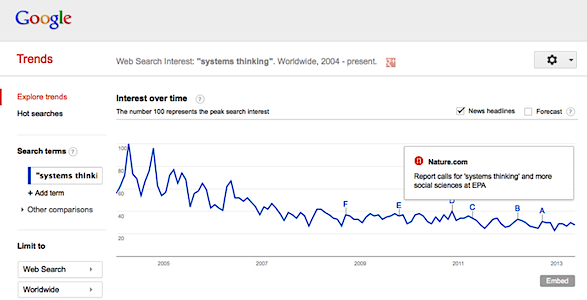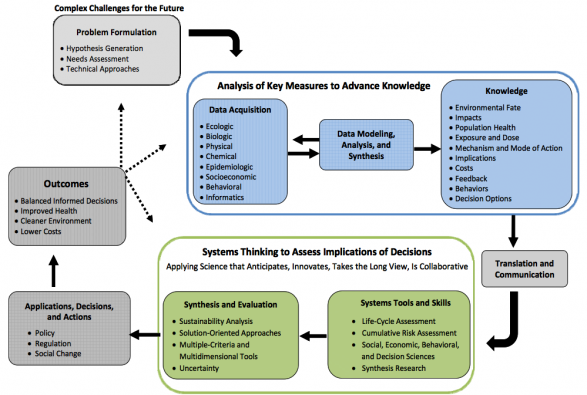 Two mysteries in this Google trends search for the phrase “systems thinking”: why those peaks in 2004 (perhaps a big conference on systems thinking in management), and why the relative decline since then?
Two mysteries in this Google trends search for the phrase “systems thinking”: why those peaks in 2004 (perhaps a big conference on systems thinking in management), and why the relative decline since then?
Despite declining search volume, a 2012 U.S. National Academy of Sciences publication, Science for Environmental Protection: The Road Ahead, which came to my attention via this search, calls for systems thinking at the Environmental Protection Agency.
From the Nature article by Jeff Tollefson (“Report calls on US environment agency to embrace social sciences”):
The US National Research Council has released an overarching review of science at the Environmental Protection Agency (EPA), advising the federal agency to take a systems view and integrate the social sciences as it tackles an increasingly complex set of issues in the coming decades.
From the report’s final chapter on Findings and Recommendations:
SYSTEMS THINKING
It is important for EPA to try to balance its capacity and resources to address complex environmental challenges, to address potential favorable and unfavorable health and environmental effects, and to apply emerging scientific information, tools, techniques, and technologies. Approaching problems from a systems perspective will allow EPA to meet those challenges and make the maximum continuing use of new scientific tools.The committee has suggested ways in which the agency can integrate systems-thinking techniques into a 21st century framework for science to inform decisions (see Figure 6-1). That framework will help EPA to stay at the leading edge of science by encouraging it to produce science that is anticipatory, innovative, long-term, and collaborative; to evaluate and apply emerging tools for data acquisition, modeling, and knowledge development; and to develop tools and methods for synthesizing science, characterizing uncertainties, and integrating, tracking, and assessing the outcomes of actions. If effectively implemented, the framework would help to break the silos of the agency and promote collaboration among different media, time scales, and disciplines.
In supporting environmental science and engineering for the 21st century, there will need to be a move from using science to characterize risks, to applying science holistically to characterize both problems and solutions at the earliest possible time. ORD’s [Office of Research and Development’s] move toward embracing sustainability throughout its research program is a positive move in this direction.
Finding: Environmental problems are increasingly interconnected. EPA can no longer address just one environmental hazard at a time without considering how that problem interacts with, is influenced by, and influences other aspects of the environment.
Recommendation 1: The committee recommends that EPA substantially enhance the integration of systems thinking into its work and enhance its capacity to apply systems thinking to all aspects of how it approaches complex decisions.

FIGURE 6-1 Framework for enhanced science for environmental protection. The iterative process starts with effective problem formulation, in which policy goals and an orientation toward solutions help to determine scientific needs and the most appropriate methods. Data are acquired as needed and synthesized to generate knowledge about key outcomes. This knowledge is incorporated into an array of systems tools and solutions-oriented synthesis approaches to formulate policies that best improve public health and the environment while taking account of social and economic impacts. Once science-informed actions have been implemented, outcome evaluation can help determine whether refinements to any previous stages are required (see the dotted lines in the figure).

